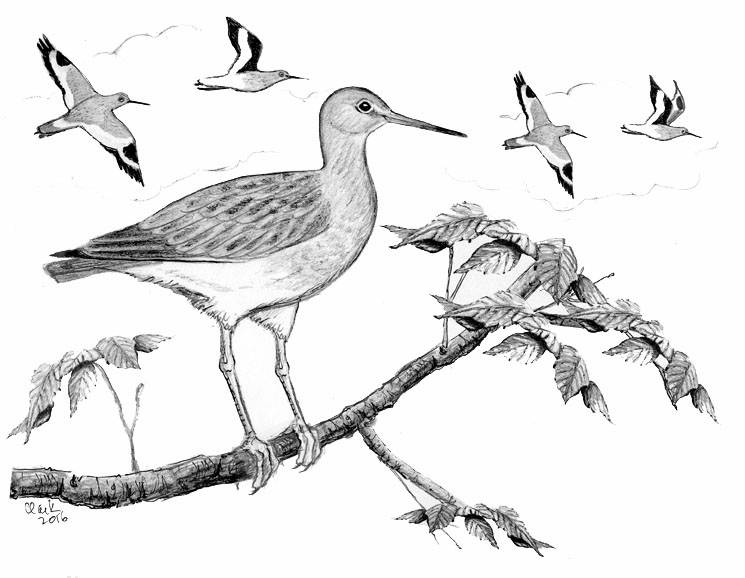
Dear Bird Folks,
I know you get a lot of questions, so I hate to bother you, but this odd bird really has me stumped. Recently, on a morning bike ride to Eastham’s First Encounter Beach, I saw these birds flying over the dunes (see photo). Then one landed in a tree. It looks like a shorebird, but in a tree? Can you tell me what kind of bird it is?
– Ron, Eastham, MA
It’s okay, Ron,
Don’t ever be afraid to ask me a question. That’s the reason I get paid the big bucks (or at least that would be the reason if I actually got paid). I honestly don’t mind answering questions, even repeat questions…except for the hummingbird food recipe question (four parts water to one part sugar). I wouldn’t object to taking a break from that one.
The bird in your photo is a Willet. In spite of its ambiguous name (and your doubts about it being a shorebird), Willets actually are sandpipers, big sandpipers. I understand why you aren’t familiar with them, because not too many years ago there were no Willets breeding on the Cape, or anywhere else in Massachusetts. I know you’ve heard this before, but during the good old market hunting days many wading birds were shot and used for hat decorations. (Can you imagine a time when wearing bird parts on your head was considered cool? That’s almost as lame as having a comb over.) Fortunately for the plain looking Willets, no one wanted them for decorations. However, they weren’t off the hook. It seems Willets taste delicious. As a result, thousands of them were turned into Willet potpies or Willet omelets because their eggs are also yummy. For nearly one hundred years not a single Willet was found breeding in Massachusetts. Then in 1976 (perhaps in honor of our Bicentennial), a pair was discovered nesting on Monomoy Wildlife Refuge (Yay!) and the local recovery was underway. Today, Willet sightings and questions are coming in every day, and unlike the hummer formula, I never get tired of answering those questions.
As I said earlier, Willets are nothing special to look at. Oh sure, they have long legs and long beaks, but their bodies are mostly gray and therefore, could be any generic shorebird. But Willets do have two features that make their identification fairly easy. One is their vocalization. Breeding Willets are noisy birds and love to repeat their names by saying: “pill-will-willet, pill-will-willet.” (Notice I used quotation marks. Willets like to be properly quoted.) The second feature is the more significant field mark hidden under their wings. A resting Willet is plainer than a vegetarian’s diet, but the moment the bird takes flight we are treated to flashes of bright white. There is also one more thing that makes Willets different than most of the other shorebirds we see on the Cape. As your photo proves, during the breeding season Willets often sit on the tops of trees, which is not our sandpipers’ usual MO.
Like you, Ron, I too have seen Willets at First Encounter Beach (and Fort Hill, West Dennis Beach, Sandy Neck and lots of other Cape beaches), but my favorite place to see them is the Wellfleet Bay Wildlife Sanctuary, which coincidently, is in Wellfleet. I’ve often seen Willets there in the summer, but this year there seems to be more than ever. When I go to Wellfleet Bay I tend to arrive early in order to avoid the crowds (and the lady who collects the admission fee). Willets are found just off the trail that leads to the extensive salt marsh and Cape Cod Bay. On my most recent visit, Willets seemed to be everywhere. They were on sitting on the ground, on tree branches, on the trailside benches and one adventurous bird was even sitting on top of an unused Osprey platform. Many birds were also in the air, performing their courtship display, which consists of wing flashing and incessantly singing, “pill-will-willet.” The action continued nonstop for quite awhile, when suddenly they all settled down and became quiet. It was as if one of the birds had abruptly called, “Time out!” After a brief break it all started up again. At this point, I decided to get a closer look, so I headed out onto the boardwalk that leads to the beach. This was not a good idea.
At first, I thought it was fun being in the middle of the Willets’ show. The noise and wing flashing were exciting, but then one bird broke away from the others and headed straight towards me. Not realizing its intent, I just stood there thinking, “This is pretty cool.” It wasn’t cool for much longer. The bird with the two-foot wingspan and a wicked long bill was headed right for my head. I’m sure we’ve all seen YouTube videos of idiots being chased by irate birds; I was now one of those goofballs. I ducked under the first attacker (although it wasn’t really that close), only to see a second bird headed my way. I quickly took the hint and moved away. The last thing I needed was for the world to find out that I was beaten up by a sandpiper. It wouldn’t look good for my super-macho image.
I’m glad you saw Willets on your bike ride, Ron. I really enjoy watching their exhilarating courtship displays. I might even call you the next time I go to look for them. It’s not that I need the company, but I’d like to borrow your bike helmet. I’m still having nightmares about those wicked long beaks.